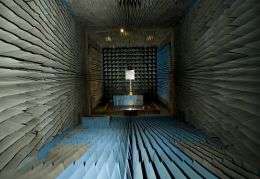Spooky Hurricane Science

There's a special room at the Marshall Space Flight Center. Researchers call it the "Anechoic Chamber" and they love to test their high-tech instruments there. Normal people think it's just plain spooky. "In here, no one can hear you scream," says engineer Mark James as he opens the door on the surreal.
The door creaks shut behind James and suddenly it's like someone hit the mute button. Dead silence. Pyramids on the wall seem to be closing in. The urge to scream ... hard to resist.
James just gets on with the job. He's lead engineer on a research team using this cavernous facility to test a prototype hurricane sensor called HIRAD. Short for Hurricane Imaging Radiometer, HIRAD is designed to scan large areas of ocean for microwave signals that portend storm strength and dynamics. By collecting and transmitting these data to forecasters, HIRAD could reduce property damage and even save lives.
The Anechoic Chamber is the perfect place to check HIRAD's antenna.
Weird shapes lining the chamber's walls are made of a radio-frequency damping material arranged in a pattern akin to soundproof rooms. The shapes minimize microwave reflections and eliminate electromagnetic interference.
"The electromagnetic quiet allows us to test and fully characterize the HIRAD antenna," explains James. "Lack of sound is just a weird bonus."
A microwave source at one end of the chamber sends signals to the HIRAD antenna at the other end. In this way, engineers can explore the antenna's beam pattern to check that it meets the requirements of the mission ahead.
Using microwaves, "HIRAD will be able to map out wind speeds on the ocean's surface--in particular the hurricane strength within the eye wall and elsewhere," says Tim Miller, HIRAD principal investigator at the National Space Science and Technology Center in Huntsville, Alabama. "We can also determine how heavy the rain is and the temperature of the ocean surface, more indicators of hurricane characteristics."
Because of its design, HIRAD can make observations over a wider swath of area than instruments currently used by NOAA. And by using electronic rather than mechanical means to scan and create a two-dimensional image of the storm's dynamics, HIRAD can operate on less power than current wind measuring instruments. It's also smaller, lighter, and relatively inexpensive to build.
"HIRAD's observations will not only give weather officials more and better real-time information on storm strength, but it will also help them determine how the storm will develop and where it will go," says Miller. "All of this adds up to more advanced warnings to the public."
How is HIRAD doing so far in the "bat cave" testing?
"We're still reviewing our test data, but so far HIRAD is passing with flying colors," says Robbie Hood of the MSFC, former principal investigator for the project and still intimately involved in its development.
The next step, she says, "is to build the real thing. This is just a test unit – a laboratory prototype. Ultimately, HIRAD will be more compact and lighter weight than the unit we're testing now."
The team hopes to have HIRAD ready to fly checkout tests onboard an aircraft by fall 2009, and ready for its first hurricane experiment in 2010. HIRAD will have to compete with other candidate instruments for the hurricane experiment.
The whole team feels confident that their instrument is going to succeed. "We've got top-notch personnel working long hours to make it happen," says Miller. "We all know that HIRAD is a valuable instrument, and we want to place it in the hands of weather officials so it can do its work -- saving lives."
The trick, says James with a smile, "is not getting locked in the bat cave."
What?
Source: by Dauna Coulter, Science@NASA




















